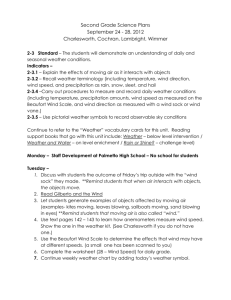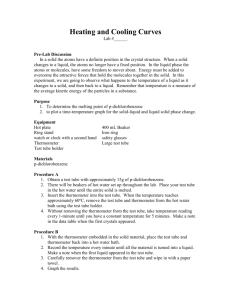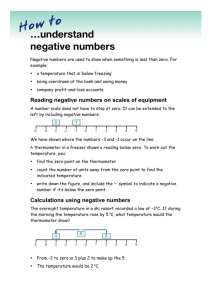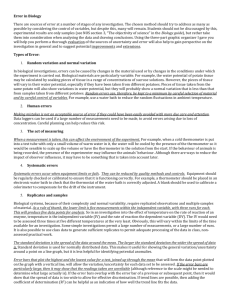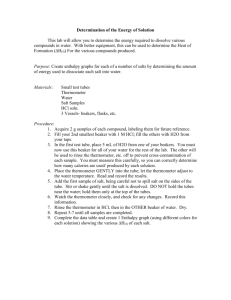Experiment 14
advertisement
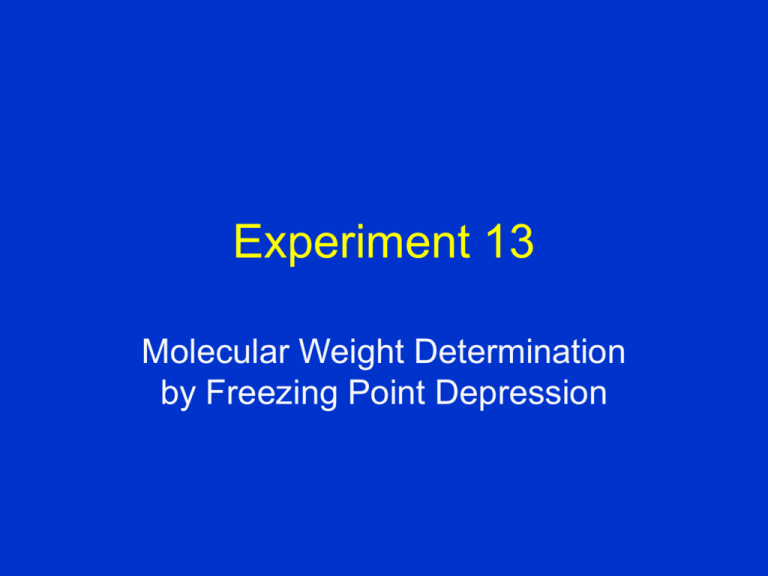
Experiment 13 Molecular Weight Determination by Freezing Point Depression Purpose • The purpose of this experiment is to use the freezing-point depression of a solution of an unknown compound in para-dichlorobenzene (PDB) to determine the molecular weight of the unknown. Introduction • What are colligative properties? • Examples of colligative properties Vapor pressure over a solution Boiling-point elevation Freezing-point depression Osmotic pressure • The first three colligative properties are closely related. • Situation: solute B dissolved in solvent A. • If the solution is ideal (not all are!), the vapor pressure over the solution follows Raoult’s Law. Raoult’s Law • PT = PAoXA + PBoXB • • • • • PT: vapor pressure of the solution PAo: vapor pressure of pure A PBo: vapor pressure of pure B XA: mole fraction of A in the solution XB: mole fraction of B in the solution PT = PAoXA + PBoXB • If solute B is nonvolatile (PBo =0), PBoXB is zero. • Raoult’s Law becomes PT = PAoXA. • Since XA is less than 1.00, PT must be less than PAo. Phase Diagram Pure A Pressure (atm) 2 1 0 270 280 290 300 310 320 Temperature (K) 330 340 350 Phase Diagram---Solution of B in A Pressure (atm) 2 1 0 270 280 290 300 310 320 Temperature (K) 330 340 350 Phase Diagram---Solution of B in A Pressure (atm) 1.25 1 0.75 320 322 324 326 328 330 332 Temperature (K) 334 336 338 340 Phase Diagram---Solution of B in A Pressure (atm) 1.25 1 0.75 280 281 282 283 284 285 286 Temperature (K) 287 288 289 290 • Note boiling-point elevation and freezing-point depression. • These temperature changes depend on the composition of the solution. • ΔT = k m FPD equation ΔT = kf m • ΔT = Tf(solution) – Tf(solvent) • kf: freezing-point depression constant for the solvent (-7.10 o/m for PDB) • m: the molality of solute (moles solute/ kg solvent) Safety • Aprons and safety glasses • Bunsen burners: keep hair, clothes, paper away. • PDB and unknowns are not soluble in water; they are also flammable and/or toxic. USE WASTE BOTTLES, NOT THE SINK, FOR DISPOSAL. Safety 2 • Thermometers are fragile and expensive; handle with care! • Do not attempt to remove the thermometer from a solidified sample. Remelt sample, then remove thermometer. Safety 3 • After experiment is over: remelt sample; remove thermometer and stirrer; pour molten sample into waste container. Then use a small amount of acetone to rinse any remaining material in test tube into waste container. Procedure • Work in pairs. • Needed equipment: Ring stand, clamp, ring, wire gauze, Bunsen burner, 1000mL beaker, largest test tube (25 x 200 mm). • Check out thermometer-stirrer-stopper assembly from stockroom. • Weigh test tube to nearest 0.01 g; record mass on data sheet. Add 20-24 g of PDB to test tube; weigh again and record mass on data sheet. • Weigh two portions of unknown, each about 1.5 grams (to nearest 0.01 g). Record masses and unknown number on data sheet. • Set up water bath and burner (p. 13-6); clamp test tube in bath. When PDB melts, fit thermometer-stirrer assembly. Remove test tube from bath and allow to cool. Stir continuously. • Begin measuring when temperature reaches 60oC. Record temperature every 30 seconds. Note when solid first appears. After 8 minutes, stop collecting data. • Do not attempt to remove thermometer now! PDB cooling curve 60 temp (oC) 59 58 57 56 55 54 53 52 0 2 4 time (min) 6 8 • Remelt PDB; test tube clamped in bath. • Remove thermometer assembly. • Add first portion of unknown. • Swirl/stir/mix until unknown dissolves. • Replace thermometer. • Remove sample from water bath. • Begin recording temperature as before when solution has cooled to about 60oC. • Note temperature at which solid first appears. • Stop collecting data after eight minutes. • Remelt sample. Remove thermometer assembly. • Add second portion of unknown (total mass of solute in this run is the sum of the two individual masses). • Dissolve unknown. • Cool and collect data as before. • After last run, remelt mixture, remove thermometer assembly, and pour mixture into waste container. • Use small volume of acetone to rinse remaining material from test tube into waste bottle. • Rinse thermometer assembly with acetone (into the waste bottle) and return thermometer assembly to stockroom. Calculations • Graph temperature vs time; plot all three runs on one graph. Temperature (C) Cooling curves Expt. 13 60 59 58 57 56 55 54 53 52 51 50 49 48 0 2 4 Time (min) 6 8 • Extrapolate lines to get freezing point for each run. • Get DT values for each sample containing unknown: DT = Tsolution – Tsolvent • Calculate molality from DT = kfm (kf = -7.10 oC/m) Moles solute = molality x kg PDB mass_solut e MW moles_solu te • Average MW values from the two runs.



